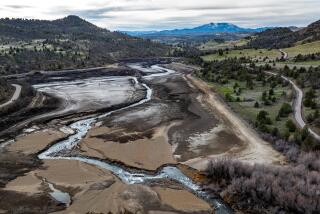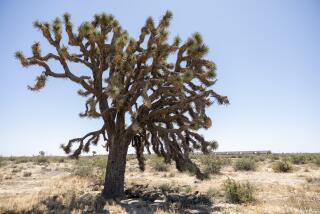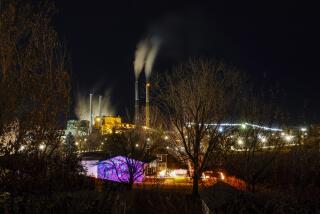Company Roots Out Environmental Damage
- Share via
HELENA, Mont. — When 46,000 plants are put in the ground on mined Navajo land in Arizona in October, the work will be steered by a Montana company with a niche in the vast business of trying to undo environmental damage.
Bitterroot Restoration Inc., headquartered in a historic farmhouse outside Corvallis, Mont., found its footing by employing a comprehensive approach to healing disturbed land.
Although many environmental consulting firms draw up a plan and then have subcontractors do the work, Bitterroot tackles the job differently. It does the planning, raises the plants used in helping sites recover, employs the planting crews and performs the follow-up.
With expansion over the last 15 years, the company has added two branches in California and employs about 85 people full time plus 50 seasonals.
Key to the business are Bitterroot’s nurseries at Corvallis and Lincoln, Calif., with combined annual production of more than 2 million plants native to the places where they’ll be used.
Bitterroot recently got a $5-million Army Corps of Engineers contract for watershed and abandoned-mine work.
“There’s a huge amount of [remediation] work going on out there right now,” said Pat Burke, a founder who got the idea for the company in the mid-1980s as a University of Montana graduate student in plant ecology.
“It’s a recognition that we can’t go on forever causing major kinds of environmental disturbances and doing nothing to clean them up,” Burke said. “The backlog is huge.”
Bitterroot’s ability to supply hardy native seedlings is a key feature that distinguishes the company from other consultants, Burke said.
In the Arizona project, Bitterroot is working in the area of the Black Mesa mine near Kayenta to restore plants significant in the Navajo culture. They include pinyon pine, penstemon, Indian paintbrush and Utah juniper. The fall planting is set for the last two weeks in October.
“There’s a fair number of companies out there and more being added all the time,” said Vern Pfannenstiel, a project spokesman for Peabody Western Coal Co., which hired Bitterroot for the Arizona work.
Pfannenstiel has used the company for about 15 years on a variety of projects.
He figures Bitterroot’s attention to detail in site preparation and nursery procedures has doubled or tripled the survival rate of seedlings at Black Mesa. Since 1996, the company has planted more than 100,000 trees, shrubs and other plants there.
“They’re the best farmers in the business,” said Carol Russell, who is on the mining team at the U.S. Environmental Protection Agency’s regional office in Denver. “They seem to do a great job of getting plants to grow where others aren’t able to.”
At Marine Corps Air Station Miramar in San Diego, Bitterroot is working on a habitat project intended to help the California coastal gnatcatcher, a threatened songbird. At the southern end of Lake Tahoe on the California-Nevada border, the company has a project that includes building wetlands where a parking lot once stood.
Other work has included flood recovery at Yosemite National Park; efforts to improve habitat for threatened bull trout in the Thompson River of Montana; environmental repair along the scenic Beartooth Highway east of Yellowstone National Park; and revegetation to control asbestos at a Coalinga, Calif., mine in the federal Superfund program.
The five-year, $5-million Corps of Engineers contract is for evaluation of abandoned mine sites in various parts of the West and development of plans to deal with the damage. The contract also includes watershed planning for California’s San Joaquin Delta and the Bay Area.
In Montana, Bitterroot operates from an old farm across from the Teller Wildlife Refuge, in the southwest corner of the state.
More than half the work is in California, but Burke said the company is based in Montana because that is where he and his colleagues want to live.
Doing business from Montana means putting up with some inconveniences, including lean air service. But Burke finds those balanced by many things, including Montana’s cachet. People like the notion of an environmental company operating from a state known for its natural splendor, he said.
More to Read
Inside the business of entertainment
The Wide Shot brings you news, analysis and insights on everything from streaming wars to production — and what it all means for the future.
You may occasionally receive promotional content from the Los Angeles Times.










